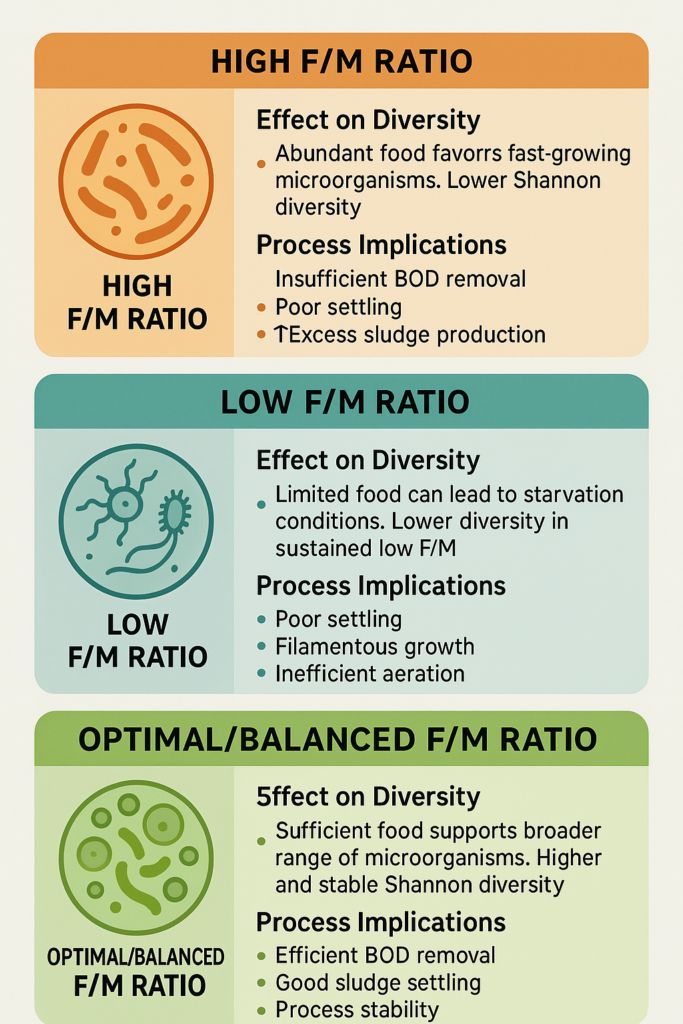
The Shannon Diversity Index (H’) is a widely used metric in ecology to quantify the biodiversity of a community. In the context of wastewater treatment, it measures the diversity and evenness of microbial species within the activated sludge biomass. This diversity is significantly influenced by operational parameters such as the Food-to-Microorganism (F/M) ratio and Mean Cell Residence Time (MCRT).
Here’s how they relate:
Food-to-Microorganism (F/M) Ratio:
The F/M ratio represents the amount of available “food” (organic matter, typically measured as BOD or COD) per unit of microorganisms (measured as MLVSS or MLSS) in the aeration tank. It dictates the “feeding” conditions for the microbial community.
- High F/M Ratio:
- Effect on Diversity: A high F/M ratio means there’s an abundance of readily available food. This generally favors fast-growing, “r-strategist” microorganisms that can rapidly consume the organic matter. While these organisms proliferate quickly, they often outcompete slower growing, more specialized microbes. This can lead to a decrease in Shannon diversity (lower species richness and/or evenness) as a few dominant species take over.
- Process Implications: Can result in insufficient BOD removal, poor settling (due to the growth of filamentous bacteria, which thrive in high F/M conditions), and an increase in excess sludge production.
- Low F/M Ratio:
- Effect on Diversity: A very low F/M ratio means there’s limited food available for the microbial population. This can lead to “starvation” conditions. While it might promote the growth of some slower-growing, “K-strategist” organisms (which are often crucial for specific removal processes like nitrification or phosphorus removal), a sustained low F/M can also decrease diversity by pushing out less competitive species and potentially favoring the growth of undesirable filamentous bacteria. Extreme low F/M can lead to cell death and a less viable biomass.
- Process Implications: Can cause poor settling, promote filamentous growth, and lead to inefficient use of aeration (wasting energy).
- Optimal/Balanced F/M Ratio:
- Effect on Diversity: Maintaining an optimal F/M ratio (which varies depending on the specific wastewater and treatment process) generally supports a higher and more stable Shannon diversity. This balance provides sufficient food for a broad range of microorganisms, allowing for a more resilient and functionally diverse community. A diverse community is better equipped to handle variations in influent composition and shock loads.
- Process Implications: Leads to efficient BOD removal, good sludge settling characteristics, and overall process stability.
Mean Cell Residence Time (MCRT) / Solids Retention Time (SRT):
MCRT (also known as Sludge Age or SRT) represents the average time in days that microorganisms are retained within the activated sludge system. It is inversely related to the F/M ratio; generally, a longer MCRT corresponds to a lower F/M, and vice-versa.
- Long MCRT:
- Effect on Diversity: A longer MCRT means microorganisms are kept in the system for an extended period. This provides enough time for slow-growing, specialized microorganisms (like nitrifying bacteria and phosphate-accumulating organisms) to establish and proliferate. This often leads to a higher Shannon diversity, as a wider array of microbial guilds can thrive. It also allows for the degradation of more complex organic compounds.
- Process Implications: Favors nitrification and denitrification, can lead to better sludge settling (if not excessively long, which can induce filamentous growth), and generally results in lower excess sludge production. However, excessively long MCRT can lead to endogenous respiration and potential issues like foaming due to Nocardia.
- Short MCRT:
- Effect on Diversity: A shorter MCRT means microorganisms are wasted from the system more frequently. This selects for fast-growing organisms that can reproduce quickly enough to maintain their population despite the high wasting rate. It often leads to a lower Shannon diversity as slower-growing, more specialized microbes are “washed out” of the system before they can establish sufficient populations.
- Process Implications: May not allow for effective nitrification or other specialized biological processes. Can lead to poor effluent quality due to incomplete organic removal and high suspended solids.
Interrelationship and Overall Impact on Shannon Diversity:
F/M and MCRT are intrinsically linked and together define the selective pressures on the microbial community.
- Stable MCRT leads to a stable F/M ratio. This stability is crucial for fostering a consistent and robust microbial community.
- Optimal ranges for F/M and MCRT promote a healthy and diverse biomass. A high Shannon diversity often correlates with a resilient and efficient activated sludge system, capable of handling various pollutants and maintaining stable performance.
- Deviations from optimal F/M and MCRT can lead to a shift in microbial community structure, often resulting in reduced diversity and potential operational problems (e.g., bulking, foaming, poor nutrient removal).
In summary, the Shannon diversity index in wastewater biomass is a valuable indicator of the health and resilience of the activated sludge system. By carefully controlling the F/M ratio and MCRT, wastewater treatment plant operators can manage the microbial community structure to achieve optimal treatment performance and maintain a diverse and stable biomass.
